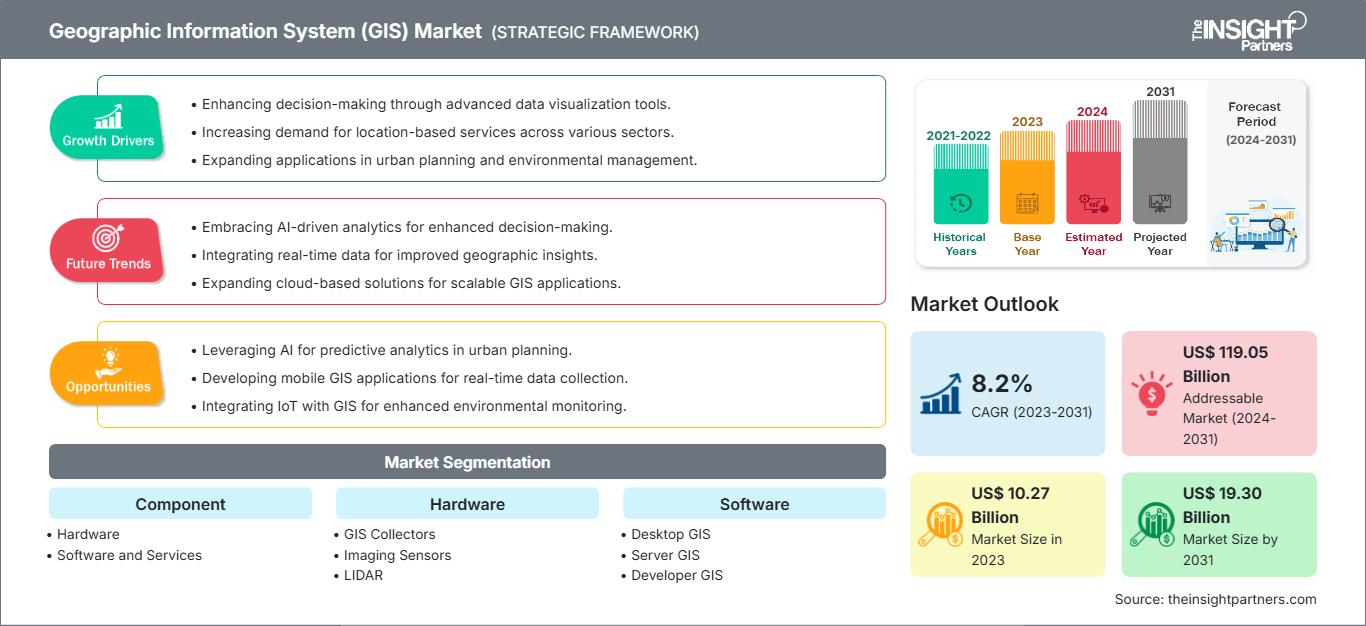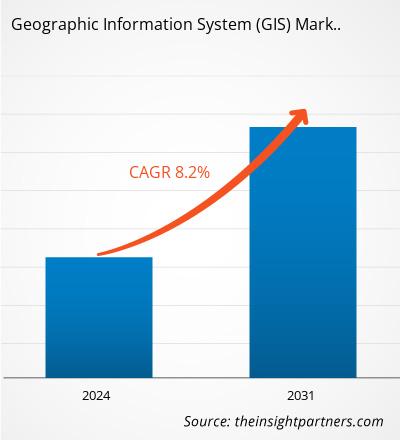지리정보시스템(GIS) 시장 규모는 2023년 102억 7천만 달러에서 2031년 193억 달러로 성장할 것으로 예상됩니다. 2023년부터 2031년까지 연평균 성장률(CAGR) 8.2%를 기록할 것으로 예상됩니다. AI, Gen AI, 증강현실 기반 GIS 솔루션의 출시는 향후 몇 년 동안 시장에 새로운 트렌드를 가져올 것으로 예상됩니다.
지리정보시스템(GIS) 시장 분석
자연재해 예측 수요 증가로 인해 GIS 시장은 예측 기간 동안 상당한 성장이 예상됩니다. GIS는 폭풍, 허리케인, 폭우 등의 정확한 예측에 널리 사용됩니다. GIS는 필수적인 공간 데이터, 이미지 및 분석을 제공하여 이러한 자연재해의 영향을 예측하고 완화하는 데 중요한 역할을 합니다. USAFacts Organizations에 따르면 미국에서는 매년 65,000건 이상의 자연재해가 기록됩니다. 미국 정부는 고급 GIS 솔루션을 사용하여 자연재해 사건을 예측하고 예보합니다. 1980년부터 2023년까지 미국은 400건 이상의 날씨 및 기후 관련 자연재해를 기록하고 견뎌냈으며 전체 피해 비용은 2조 7,800억 달러를 초과했습니다. 2024년 11월에 10억 달러 이상의 비용이 드는 약 24건의 날씨 관련 자연재해 사건이 기록되었습니다. 이러한 자연재해에는 산불 사건 1건, 폭풍 사건 17건, 열대성 저기압 사건 4건, 겨울 폭풍 사건 2건이 포함됩니다. 또한 유럽 위원회 조직에 따르면 남유럽에서는 2022년에 산불로 90만 헥타르가 소실되었습니다. 또한 2023년에는 산불로 50만 헥타르 이상이 불탔으며 주로 이탈리아, 그리스, 스페인, 포르투갈에서 발생했습니다. 이러한 자연재해를 예방하고 추가 피해 비용을 줄이기 위해 지리정보시스템(GIS)에 대한 수요가 증가하고 있습니다. 따라서 자연재해 예측에 대한 필요성은 지리정보시스템 시장 성장을 촉진합니다.
농부들은 GIS 솔루션을 사용하여 농경지 데이터를 매핑하고 원격으로 작물을 분석, 정리 및 모니터링합니다. GPS 및 GIS 통합 시스템은 농경지 작물의 수확량, 물 필요량과 같은 실시간 데이터를 수집하는 데 도움이 됩니다. 또한 농부들은 GIS 솔루션을 사용하여 자원 활용도를 높이고 작물 품종, 경작지 경계, 표고, 관개 시스템 등을 분석합니다. 따라서 농업 부문에서 GIS 솔루션 도입이 증가함에 따라 예측 기간 동안 지리정보시스템 시장 성장에 수익성 있는 기회가 제공될 것으로 예상됩니다.
지리정보시스템(GIS) 시장 개요
지리정보시스템(GIS) 소프트웨어는 방대한 양의 정보를 종합하는 데 사용되며, 데이터를 효율적으로 관리하고 검색하는 데 도움을 줍니다. GIS의 다양한 최종 사용자는 물류 및 운송, 농업, 석유 및 가스, 건설, 광업, 에너지 및 공공 서비스, 그리고 기타 여러 산업입니다. GIS는 지리적으로 참조되는 정보를 저장, 통합, 편집, 공유, 분석 및 표시할 수 있습니다. 사용자는 GIS를 통해 대화형 쿼리를 생성하고, 공간 정보 지도를 분석하고, 데이터를 편집하고, 이러한 모든 작업의 결과를 제시할 수 있습니다. GIS 기술은 다양한 원격 탐사 정보와 지도를 결합하여 다양한 모델을 생성하는 데 필수적인 도구입니다. GIS 소프트웨어는 농업 과학자들이 지리 데이터를 활용하고 농업 발전을 위한 계획 활동을 실행함으로써 농부들에게 더 나은 서비스를 제공할 수 있도록 하는 강력한 솔루션입니다.
이 보고서의 일부, 국가 수준 분석, Excel 데이터 팩을 포함하여 모든 보고서에 대한 사용자 정의를 무료로 받을 수 있을 뿐만 아니라 스타트업 및 대학을 위한 훌륭한 제안 및 할인을 이용할 수 있습니다
지리 정보 시스템(GIS) 시장: 전략적 통찰력

- 이 보고서의 주요 주요 시장 동향을 확인하세요.이 무료 샘플에는 시장 동향부터 추정 및 예측에 이르기까지 데이터 분석이 포함됩니다.
지리정보시스템(GIS) 시장 성장 동력 및 기회
물류, 운송 및 인프라 부문의 실시간 위치 기반 서비스에 대한 높은 수요
유엔의 2022년 보고서에 따르면, 전 세계 물류 산업은 2023년 약 9조 4천억 달러 규모로 성장했으며, 2024년에는 9조 9천억 달러에 달할 것으로 예상되며, 연평균 5.3%의 성장률을 보일 것으로 전망됩니다. 운송 및 물류 부문에서 지리정보시스템(GIS)은 실시간 교통 모니터링 및 실시간 차량 추적에 활용됩니다. GIS는 공간 데이터를 시각적으로 표시하여 모니터링 기능을 제공하고, 모니터링 대상 차량의 정확한 지리적 실시간 위치를 제공합니다. 또한, GIS 매핑 솔루션은 새로운 철도 노선, 도로 및 기타 운송 경로를 생성하는 데 널리 사용됩니다. 전 세계적으로 도로 및 철도 인프라 개발에 대한 투자는 계속해서 빠르게 증가하고 있습니다. 글로벌 인프라 전망 보고서에 따르면, 2023년 전 세계 교통 인프라 투자는 미화 1조 6,000억 달러에 달했습니다. 지리정보시스템(GIS)은 교통 인프라 계획 및 관리 과정에서 공간 데이터 분석 및 시각화에 널리 활용되며, 효율성 향상, 비용 절감, 안전성 및 지속가능성 향상 등 다양한 이점을 제공합니다. 세계은행에 따르면, 글로벌 도로 목록 프로젝트(Global Roads Inventory Project)는 도로 인프라 관련 60개 이상의 지리공간 데이터셋으로 구성되어 있습니다. 이 데이터셋은 약 222개국을 포괄하며, 2,100만km에 달하는 도로의 로드맵을 포함하고 있습니다. 지리정보시스템은 이러한 국가의 지리공간 데이터를 추출하는 데 사용됩니다. 따라서 물류, 운송 및 인프라 부문의 실시간 위치 기반 서비스에 대한 높은 수요는 GIS 시장의 성장을 촉진하고 있습니다.
농업 부문에서 GIS 솔루션 도입 증가
시장의 여러 주요 업체들이 농업 부문을 위한 첨단 기술 기반 GIS 솔루션을 개발하고 있습니다. 예를 들어, 2024년 7월, Ecopia AI는 벡터 데이터를 사용하여 3D 전국 토지 데이터셋의 새로운 수준을 추출하는 새로운 농업 토지 이용 데이터를 출시했습니다. 이러한 평면 벡터 데이터 레이어를 통해 정부 기관은 토지 개발, 용수 사용, 유출량 계산, 세금 평가 및 기타 세부 분석 워크플로와 관련된 심층적인 지리공간 분석을 수행할 수 있습니다. 2022년에는 건물, 수목, 농경지, 교량 등을 매핑하기 위한 14개의 고정밀 2D 데이터 레이어를 제공하는 3D 전국 토지 피복(3D Nationwide Land Cover)을 출시했습니다. 2024년 3월, Agribazaar는 인도 우타르프라데시 주에 위치한 농부들을 위한 AI 기반 GIS 커맨드 센터를 구축했습니다. 이 프로젝트는 우타르프라데시 주 75개 구에 걸쳐 57,000개 그램 판차야트의 농업 데이터를 디지털 방식으로 시각화하기 위해 시작되었습니다. 2024년 5월, GNSS 기술 솔루션 제공업체인 CHC Navigation은 안드로이드 기기용 데이터 수집 및 매핑 애플리케이션을 위한 고급 GIS 솔루션 중 하나인 MapCloud를 출시했습니다. 이 MapCloud는 다양한 산업 분야의 엔지니어, 측량사, 농부 및 GIS 전문가에게 강력한 현장 데이터 수집 도구를 제공합니다. 따라서 농업 분야에서 GIS 솔루션 도입이 증가함에 따라 지리정보시스템(GIS) 시장 성장 기회가 제공될 것입니다. 지리정보시스템(GIS) 시장 보고서 세분화 분석 지리정보시스템(GIS) 시장 분석 도출에 기여한 주요 세그먼트는 구성 요소, 기능, 최종 사용자입니다. 구성 요소별로 시장은 하드웨어, 소프트웨어, 서비스로 세분화됩니다. 2023년에는 소프트웨어 부문이 시장을 장악했습니다.
지역별 지리 정보 시스템(GIS) 시장 점유율 분석
지리 정보 시스템(GIS) 시장은 북미, 유럽, 아시아 태평양(APAC), 중동 및 아프리카(MEA), 중남미의 5개 주요 지역으로 세분화됩니다. 2023년에는 북미 지역이 시장을 장악했으며, 유럽과 아시아 태평양 지역이 그 뒤를 이었습니다. 북미 지리정보시스템(GIS) 시장은 스마트 시티 인프라, 기술 발전, 그리고 산업 전반에 걸친 적용 확대 등 여러 핵심 요인으로 인해 크게 성장하고 있습니다. 미국과 캐나다의 스마트 시티 사업은 공공 서비스, 교통 시스템, 그리고 공공 서비스를 관리하기 위해 GIS에 크게 의존하고 있습니다. 또한, 북미 여러 국가 정부들은 이 지역의 스마트 그리드 인프라를 확충하기 위한 다양한 사업을 추진하고 있습니다. 예를 들어, 2022년 9월, 미국 에너지부(DOE)는 국가 전력망 강화를 위한 스마트 그리드 및 기타 업그레이드 프로그램에 105억 달러를 투자했습니다. 마찬가지로, GI 스마트 그리드 프로그램은 청정 성장 및 기후 변화에 관한 범캐나다 프레임워크(Pan Canadian Framework)의 목표를 달성하기 위해 주요 인프라 구축을 목표로 하는 캐나다 천연자원부(Natural Resource Canada)의 국가적 집중 프로그램 중 하나였습니다. 스마트 그리드 프로그램은 2023년에 갱신되었습니다. GIS는 향상된 모니터링, 정확한 모델링, 데이터 통합, 전략적 계획 및 효과적인 커뮤니케이션을 가능하게 하는 스마트 그리드에 널리 사용되는 기술입니다.
지리 정보 시스템(GIS) 시장 지역별 통찰력
The Insight Partners의 분석가들은 예측 기간 동안 지리 정보 시스템(GIS) 시장에 영향을 미치는 지역별 동향과 요인을 면밀히 분석했습니다. 이 섹션에서는 북미, 유럽, 아시아 태평양, 중동 및 아프리카, 그리고 중남미 지역의 지리 정보 시스템(GIS) 시장 부문 및 지역별 현황도 다룹니다.
지리 정보 시스템(GIS) 시장 보고서 범위
| 보고서 속성 | 세부 |
|---|---|
| 시장 규모 2023 | US$ 10.27 Billion |
| 시장규모별 2024-2031 | 2024-2031 |
| 글로벌 CAGR (2023 - 2031) | 8.2% |
| 이전 데이터 | 2021-2022 |
| 예측 기간 | 2024-2031 |
| 다루는 세그먼트 |
By 구성 요소
|
| 포함된 지역 및 국가 | 북미
|
| 시장 선도 기업 및 주요 회사 프로필 |
|
지리 정보 시스템(GIS) 시장 참여자 밀도: 비즈니스 역학에 미치는 영향 이해
지리정보시스템(GIS) 시장은 소비자 선호도 변화, 기술 발전, 그리고 제품 이점에 대한 인식 제고 등의 요인으로 인한 최종 사용자 수요 증가에 힘입어 빠르게 성장하고 있습니다. 수요가 증가함에 따라 기업들은 제품 및 서비스 확장, 소비자 니즈 충족을 위한 혁신, 그리고 새로운 트렌드를 적극 활용하고 있으며, 이는 시장 성장을 더욱 가속화하고 있습니다.

- 을 얻으세요 지리 정보 시스템(GIS) 시장 주요 주요 플레이어 개요
지리정보시스템(GIS) 시장 뉴스 및 최근 동향
지리정보시스템(GIS) 시장은 1차 및 2차 조사 이후 주요 기업 간행물, 협회 데이터, 데이터베이스 등 정성적 및 정량적 데이터를 수집하여 평가합니다. 지리정보시스템(GIS) 시장의 주요 동향은 다음과 같습니다.
- GIS 솔루션 분야의 선도 기업인 GEOJobe GIS Consulting은 지향성 영상(Oriented Imagery) 소프트웨어 분야의 선두 기업인 AerialSphere와의 새로운 리셀러 파트너십을 발표했습니다. 이 파트너십은 GIS 커뮤니티 내 더 광범위한 대상에게 AerialSphere의 최첨단 지향형 영상(Oriented Imagery) 기술의 도달 범위를 확장하는 데 있어 중요한 이정표입니다.
(출처: AerialSphere, 보도자료, 2024년 7월)
- 지리정보시스템(GIS) 기술 및 위치 정보 분야의 글로벌 리더인 Esri는 건축, 엔지니어링, 건설 및 운영(AECO) 산업을 위한 빌딩 정보 모델링(BIM) 기술 분야의 글로벌 리더인 Autodesk, Inc.(NASDAQ: ADSK)와 협력하여 전략적 제휴를 강화하고 있습니다.
(출처: Esri, 보도자료, 2024년 10월)
지리정보시스템(GIS) 시장 보고서 범위 및 제공 내용
"지리정보시스템(GIS) 시장 규모 및 예측(2021~2031)"은 언급된 영역을 포괄하는 시장에 대한 자세한 분석을 제공합니다. 아래:
- 범위에 포함된 모든 주요 시장 세그먼트에 대한 글로벌, 지역 및 국가 수준의 지리 정보 시스템(GIS) 시장 규모 및 예측
- 지리 정보 시스템(GIS) 시장 동향 및 추진 요인, 제약 및 주요 기회와 같은 시장 역학
- 상세한 PEST 및 SWOT 분석
- 주요 시장 동향, 글로벌 및 지역 프레임워크, 주요 참여자, 규정 및 최근 시장 개발을 다루는 지리 정보 시스템(GIS) 시장 분석
- 시장 집중도, 히트맵 분석, 주요 참여자 및 지리 정보 시스템(GIS) 시장의 최근 개발을 다루는 산업 환경 및 경쟁 분석
- 상세한 회사 프로필
- 과거 분석(2년), 기준 연도, CAGR을 포함한 예측(7년)
- PEST 및 SWOT 분석
- 시장 규모 가치/거래량 - 글로벌, 지역, 국가
- 산업 및 경쟁 환경
- Excel 데이터세트
최근 보고서
사용 후기
구매 이유
- 정보에 기반한 의사 결정
- 시장 역학 이해
- 경쟁 분석
- 고객 인사이트
- 시장 예측
- 위험 완화
- 전략 기획
- 투자 타당성 분석
- 신흥 시장 파악
- 마케팅 전략 강화
- 운영 효율성 향상
- 규제 동향에 발맞춰 대응




















 무료 샘플 받기 - 지리 정보 시스템(GIS) 시장
무료 샘플 받기 - 지리 정보 시스템(GIS) 시장